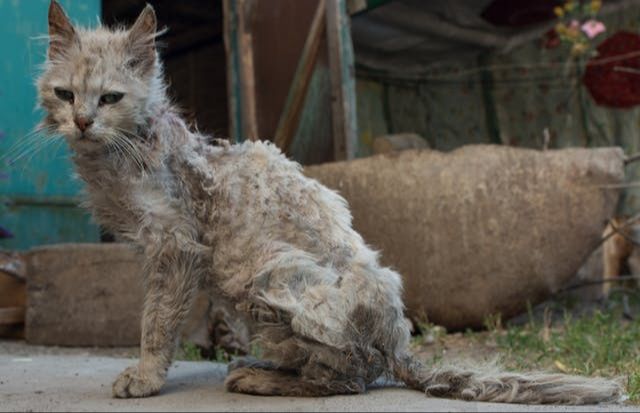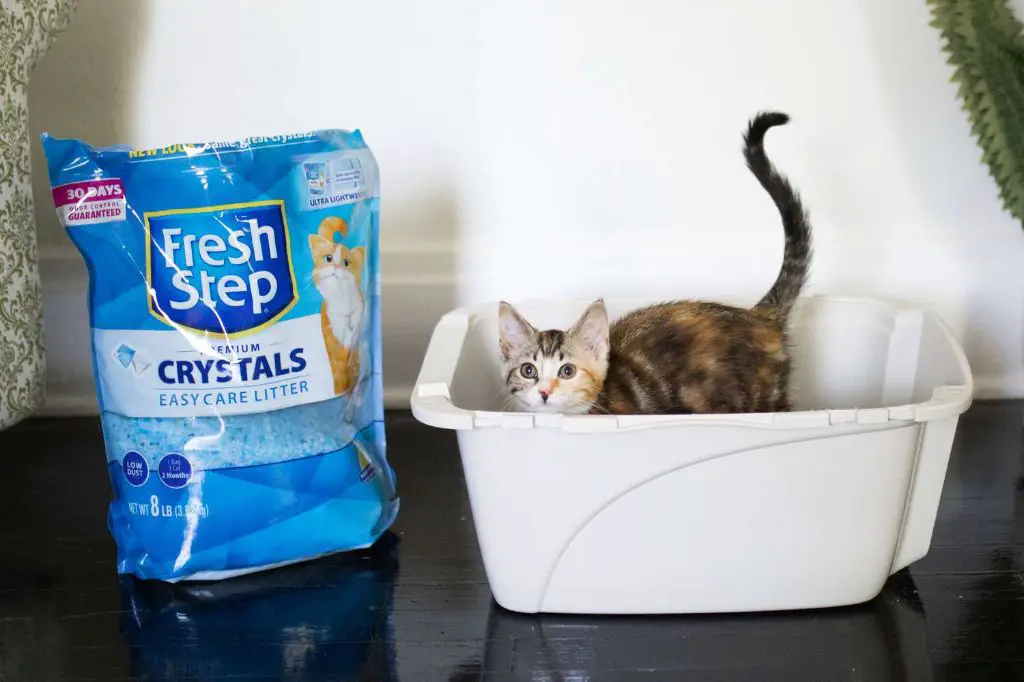Feline allergies to litter, also known as litter box allergies, are a relatively common issue among cats. Just like humans, cats can develop allergies to various substances in their environment. For cats, this often includes the material used in their litter boxes. An estimated 10-15% of cats suffer from litter allergies at some point in their lives. When a cat has a litter allergy, their immune system overreacts to certain proteins or particles in the litter, triggering an inflammatory response. This can lead to a variety of allergy symptoms, ranging from mild to severe. Litter allergies in cats can develop at any age, though kittens and young cats seem to be more susceptible. With so many types of cat litter on the market today, determining the specific allergen can be tricky. But identifying and treating litter allergies is important for a cat’s comfort and health.
Symptoms
Cats with allergies to litter can exhibit a variety of symptoms affecting the respiratory system, skin, and digestive tract. Common respiratory issues include sneezing, wheezing, coughing, and labored breathing, which can indicate irritation and inflammation in the nose, throat, and lungs (https://simplycatcare.com/best-cat-litter-for-allergies/).
Allergic reactions may also lead to skin irritation, such as redness, itchiness, and scabs around the paws and belly from contact with the litter. Cats may excessively lick or chew at their skin in an effort to relieve the itchiness (https://mrbosscat.com/best-cat-litter-for-cats-with-allergies/).
On the digestive side, symptoms can include vomiting, diarrhea, loss of appetite, and weight loss. The gastrointestinal upset indicates the cat is having an adverse reaction to ingesting or inhaling components of the litter (https://www.youtube.com/watch?v=ak3hC–5_g8).

Causes
There are several potential causes of litter allergies in cats:
Dust – Cat litter dust is one of the most common causes of allergies. As cats walk in the litter, dust particles become airborne and can be inhaled, irritating a cat’s respiratory tract. Dust-Free litters are recommended for cats with allergies.
Chemicals – Scented litters often contain chemicals and fragrances that cats can develop allergies to. Chemical dust suppressants found in some litters can also trigger allergic reactions in sensitive cats.
Perfumes – Heavily perfumed litters contain artificial fragrances that can irritate a cat’s airways and sinuses, causing respiratory distress. Unscented, fragrance-free litters are less likely to cause issues.
Natural allergens – Some cats may even develop allergies to natural substances like corn, wheat, pine, cedar, or clay. Hypoallergenic plant-based or wood litters may help reduce exposure to natural allergens.
Diagnosis
Diagnosing cat litter allergies can be challenging since cats may also be allergic to other allergens like fleas, food ingredients, pollen, or dust mites. Veterinarians use a combination of exams, elimination diets, and allergy testing to confirm cat litter is the culprit.
During a veterinary exam, the vet will perform a complete physical exam and look for signs of irritation, inflammation, or infection in areas like the skin, ears, and paws that may indicate an allergy. They will also ask about the cat’s diet and environment to identify potential allergens.
Elimination diets involve feeding the cat a novel protein and carbohydrate diet made with ingredients they have never eaten before, like venison and sweet potato, for 8-12 weeks. This helps rule out food allergies. If symptoms improve, ingredients are added back one at a time to identify the problem.

Allergy testing like intradermal skin testing or blood tests can identify specific IgE antibodies made against certain allergens. Positive results for dust mite, mold, or pollen allergens can help rule out cat litter as the primary allergen source.
Once other causes are ruled out, switching litters can help confirm a litter allergy. Veterinarians may recommend trying different textures, scents, dust-free vs. clay options to pinpoint the source of irritation.
Treatment
There are several ways to treat a cat’s allergy to litter:
Use a hypoallergenic litter made from alternative materials like pine, wheat, or corn. These tend to produce less dust and irritants than traditional clay litters. Some cats may still react to scents or components in alternative litters, so finding one that works can require some trial and error. Source
Clean the litter box more frequently to reduce buildup of allergens. Scoop clumps out daily and fully wash the litter box once or twice a week. Use mild, fragrance-free cleaners.
Medications can provide relief from allergy symptoms. Cats may be prescribed antihistamines, steroids, or immunosuppressants to reduce inflammation and itchiness. Any medication should be given under the guidance of a veterinarian.
Prevention
There are a few ways you can help prevent your cat from developing a litter allergy:
– Use unscented litters. Fragrances and perfumes added to some litters can cause irritation for cats. Opt for unscented varieties.

– Choose natural litter materials like wood, paper, or plant-based fibers. These tend to be hypoallergenic compared to clay, silica, or synthetic litters.
– Scoop and change the litter frequently to limit exposure to allergens. Cats with allergies benefit from daily scooping and completely replacing the litter every 1-2 weeks.
Risk Factors
Certain cats may be at higher risk of developing a litter allergy than others. Some of the main risk factors include:
Age
Kittens and young cats may be more prone to litter allergies. Their immune systems are still developing, making them more susceptible to new allergens.
Breed Predispositions
Some cat breeds seem more genetically prone to allergies in general, including litter allergies. These breeds include Siamese, Balinese, Burmese, and Abyssinians.
Existing Allergies
Cats with other known allergies may be at increased risk for developing a litter allergy as well. Once sensitized, their immune system may overreact to new allergens too.
For example, a cat with a food allergy or seasonal environmental allergies may go on to develop an allergy to litter ingredients too.
Prognosis
The prognosis for cats with litter allergies is usually good with proper management of symptoms.1 While there is no cure for the allergy itself, keeping the cat away from the irritating allergen through use of alternative, hypoallergenic litters can help relieve symptoms. Medications like antihistamines and corticosteroids may also be used long-term to control allergic reactions.
Depending on the severity of the allergy, lifelong management and treatment may be necessary. It’s important for cat owners to monitor their pet closely and watch for any reactions or recurring symptoms. With vigilance and proactive care, most cats with litter allergies can live normal, comfortable lives.
Living with a Cat with Litter Allergies
Living with a cat that has a litter allergy requires making some accommodations and lifestyle changes to keep your cat comfortable. Here are some tips:
- Switch to a hypoallergenic litter – Try switching to a dust-free, perfume-free litter made of materials like wood, paper, or plant fibers that are less likely to trigger allergies (https://wagwalking.com/cat/condition/litter-allergy).
- Clean the litter box frequently – Scoop waste out and change the litter often to prevent buildup of allergens (https://www.litter-robot.com/blog/allergies-in-cats/).
- Use air purifiers – Air purifiers with HEPA filters can remove allergens like dust and dander from the air.
- Limit litter dust – Use litter mats, enclosed litter boxes, and dust-reducing litter to limit airborne particulates.
- Vacuum regularly – Frequently vacuum carpets, furniture, and cat beds to remove allergens.
- Wash bedding – Wash your cat’s bedding weekly in hot water to kill dust mites.
- Groom your cat – Brush your cat frequently to remove dander and distribute natural oils.
- Give allergy medicine – Talk to your vet about antihistamines or other medications to relieve allergy symptoms.
- Avoid triggers – Keep your cat away from known allergen triggers as much as possible.

With some simple changes, you can help an allergic cat live comfortably. Monitor their symptoms and work closely with your vet to find the right allergy management plan.
Key Takeaways
Here are the key takeaways on cats developing allergic reactions to litter:
- Cats can develop allergies to chemicals, fragrances, dust, and other components commonly found in cat litter.
- Common symptoms include sneezing, wheezing, runny eyes/nose, vomiting, diarrhea, and skin irritation.
- Allergies are diagnosed through medical history, physical exam, elimination trials, and allergy testing.
- Treatment involves removing the allergen, medicating symptoms, and trying hypoallergenic litters.
- Prevention involves choosing a high-quality, hypoallergenic litter made of materials less likely to cause reactions.
- Cats prone to allergies in general are at higher risk of developing litter allergies.
For more information, see the resources cited throughout the article or consult your veterinarian. Key resources include: WagWalking, Animal Wellness, and PrettyLitter.

